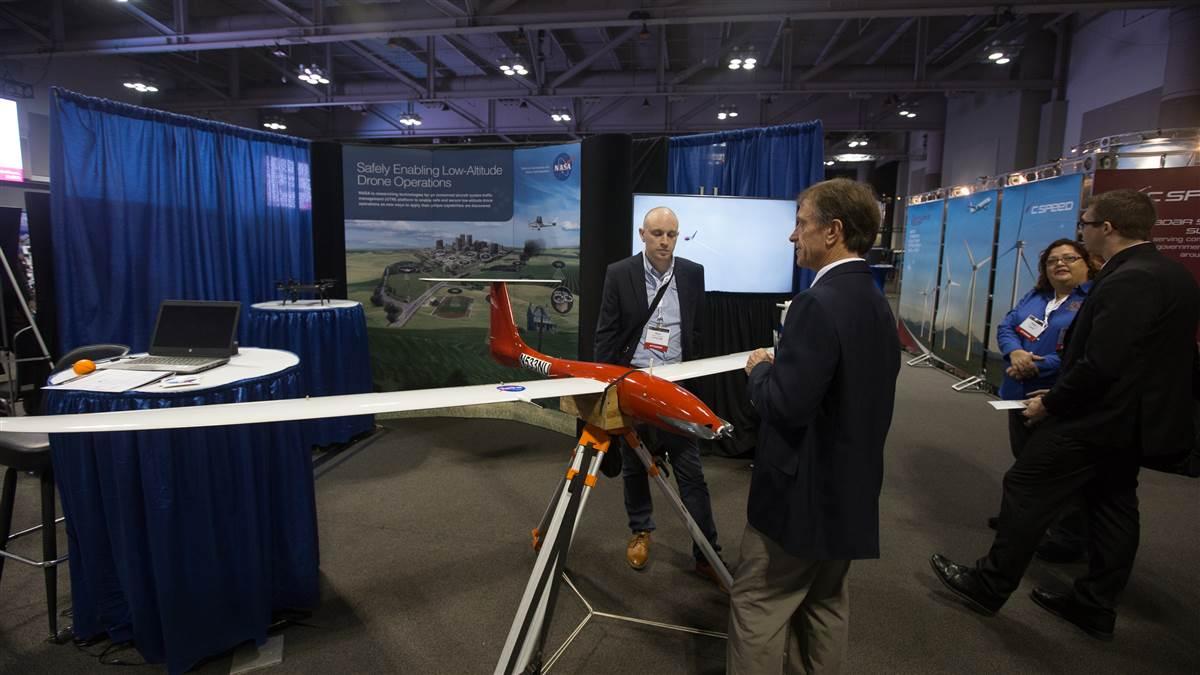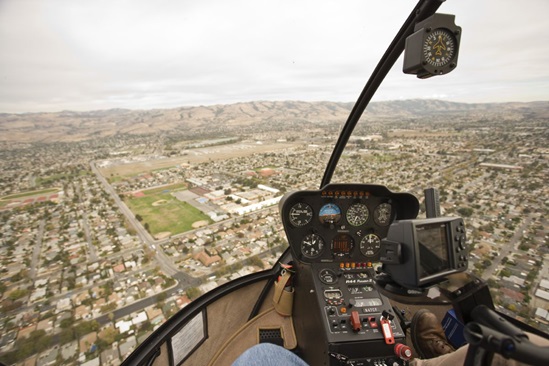Full-scale helicopters flown from afar
Lockheed Martin offers glimpse of unmanned future
Standing in front of K-MAX, a dual-rotor helicopter made for lifting loads that has already logged more than three years of flying without a pilot on board in Afghanistan, Jon McMillen, business development lead for unmanned systems at Lockheed Martin, said the goal is to have K-MAX flying firefighting missions for the U.S. Forest Service within the coming three to five years. The technology will allow operations around the clock, in conditions that would ground manned aircraft, and pilots can be trained to operate the system much more quickly than is the case with traditional aircraft.
“They’re not looking at a collective and a stick, they’re just looking at a game controller that they’re very familiar with,” McMillen said.
The demonstration also included a small, fixed-wing drone called Desert Hawk developed for military operations, a small quadcopter (also developed for military use), both used as spotters for the larger aircraft, detecting fire hot spots and stranded people. When it came time for simulated rescue, a Sikorsky S-76 lifted off and flew to the location identified by Desert Hawk, and landed to pick up passengers. A pair of test pilots, both military veterans, were in the cockpit of the modified S-76, but had little to do but keep hands, feet, and minds poised to take over if necessary. It was not necessary.
This particular S-76 is SARA, the Sikorsky Autonomy Research Aircraft that flew, autonomously, 30 miles from Bridgeport, Connecticut, to Plainville, Connecticut, in May, completing the first phase of a Pentagon program. McMillen said the company plans to have the technology, dubbed Matrix, that makes autonomous or pilot-assisted flight deployed in three to five years across the Sikorsky fleet. The concept is for a flexible system that allows aircraft like the S-76, often used for corporate and offshore oil rig missions, to be flown with a regular crew of two, a single pilot assisted by the automation technology, or with no human pilot on board at all.
While a control tower, sophisticated surveillance radar, and cameras kept watch over the demonstration, it will not be long, now, before aircraft like the K-MAX venture farther into the National Airspace System. That may not be welcome news to everyone currently using that system.
“Everything new is scary, and what we need to look at is how do we change the paradigm, how do we do events like this that show that these systems are there, they’re ready,” McMillen said. “And by having a dialogue and making sure the right systems are in place to allow everyone to feel and trust the systems that are on board, we’ll be able to migrate and start using them.”

The demonstration was viewed by hundreds of spectators who arrived on buses from Syracuse, New York, where the UTM Convention 2016 took place Nov. 8 through 10. Organized by the Air Traffic Control Association, the event drew representatives of nearly every major participant in the ongoing research developing technology to facilitate the safe integration of unmanned aircraft. Unmanned aircraft systems traffic management, or UTM, is a research program that has been for years run by NASA, and collaboration with the FAA and private industry has ramped up rapidly. Parimal Kopardekar, principal investigator for NASA UTM, who is coordinating the efforts of research teams around the country, addressed the convention Nov. 9 with a detailed briefing on the current state of development.
Recent projections, Kopardekar said, estimate there will be 7 million drones in the airspace by 2020, and a sophisticated system will be required to manage all of those flights safely, and keep them separated from each other, as well as from manned aircraft.
“We are heads-down and working like beavers to try and make this happen,” Kopardekar said. One of the key lessons learned to date is that safety depends on systems that can manage situations that deviate from the plan.
“It’s all about ability to manage disruptions, off-nominal conditions and contingencies,” Kopardekar said.
Several representatives of the FAA, many other NASA researchers, and representatives of private companies involved in the ongoing research all presented briefings and took part in panel discussions, fielding many inquiries from the audience pertaining to one of the central questions to be answered by UTM: How will the system accommodate “non-cooperators” or “non-participating” aircraft, a term that can refer to general aviation aircraft, such as a Piper Cub that flew through a NASA UAS test area (despite notams advising non-participants to steer clear) during a recent exercise. Ground-based radar detected the aircraft, and the mission concluded without incident. The Cub pilot may never have known he or she was sharing airspace with an unmanned aircraft.
“We need to expect the unexpected …. particularly non-cooperators,” Kopardekar said. “This is something we need to make sure gets handled.”
Many attendees were certificated pilots with experience flying civilian aircraft, military aircraft, or both. That includes Brian Wynne, president and CEO of the Association of Unmanned Vehicle Systems International, who holds a commercial pilot certificate and flew his own airplane to Syracuse for the convention.
Wynne said he is encouraged by the high level of cooperation between NASA and the FAA, that the FAA is working to implement the research, and that private industry has also stepped up. The resulting collaboration has produced many promising technologies, and the system that will allow all aircraft operators to maintain situational awareness and avoid collisions by leveraging a variety of technologies combined has begun to take shape.
“There is no question in my mind that this is going to keep moving forward,” Wynne said. “We’re getting on the same page. They’ve made enormous progress in the last year.”
Conference participants and presenters agreed that there will not be a single technology or solution that fits all missions, all airspace, or all aircraft. Instead, there will be a combination of systems, including radar, Automatic Dependent Surveillance-Broadcast (ADS-B), cameras, radio frequency detection, and other electronic detection systems, based in the space, on the ground, and in the air, that will allow UAS operators to “see” other aircraft—including the Piper Cubs flying without transponders or radios—and avoid them.





